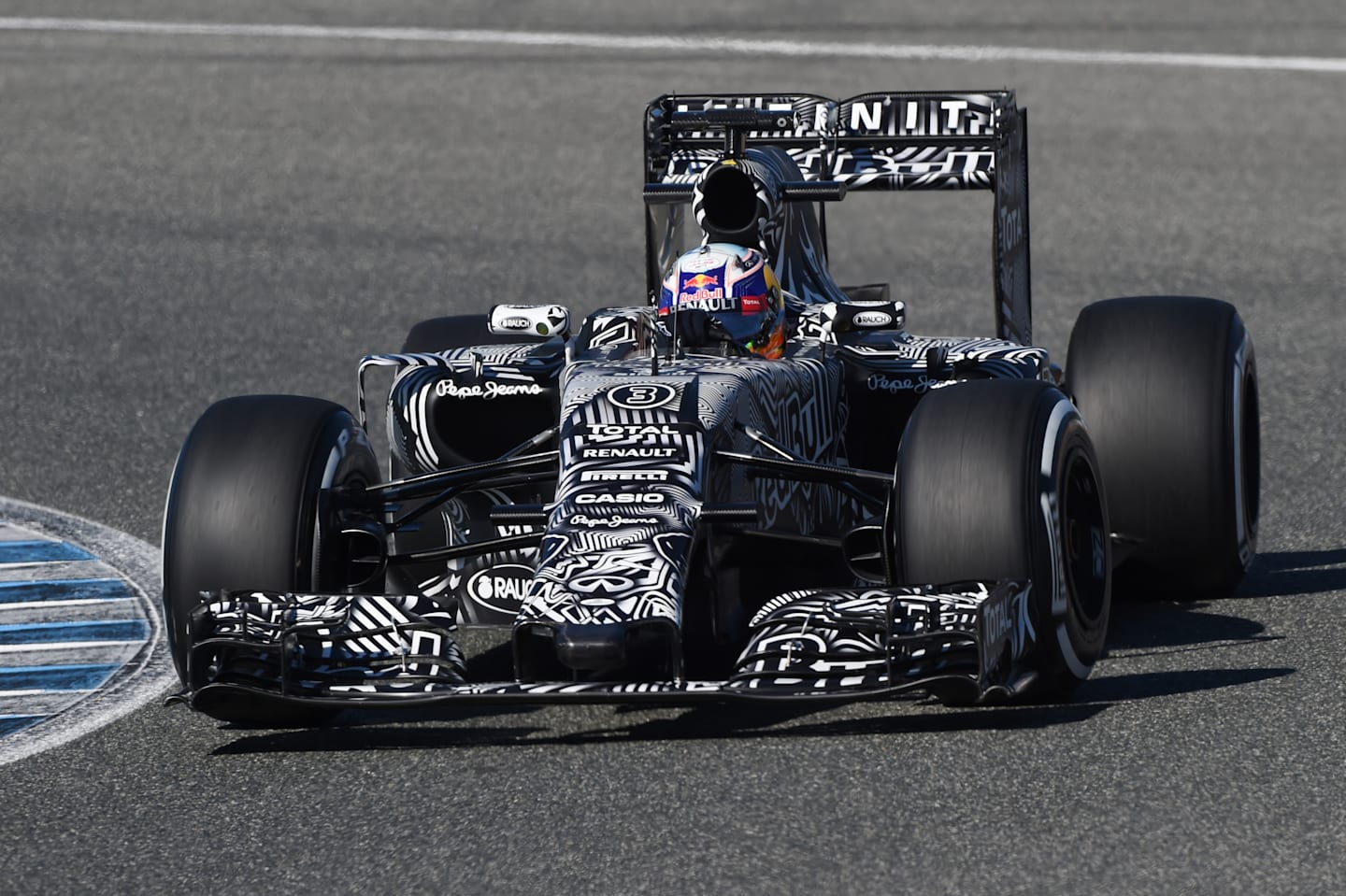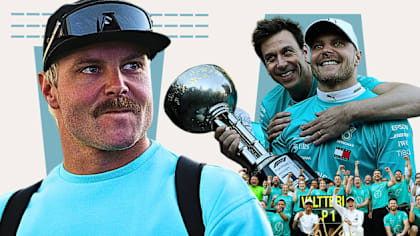After an intense period of development, a new crop of Formula One cars made their highly anticipated on-track debuts at Jerez this week. From rookie roll-outs to surprise performances, and from reliability issues to promising early pace, we take a team-by-team look at all of the action from an intriguing opening session in Spain…
Ferrari
Kimi Raikkonen, 1m 20.841s, 200 laps Sebastian Vettel, 1m 20.984s, 149 laps

Kimi Raikkonen (FIN) Ferrari SF15-T at Formula One Testing, Day Four, Jerez, Spain, 4 February 2015.
Taken in isolation, Ferrari had the best of Jerez: fastest on three of the four days, they also emerged with the two quickest times and the fourth highest lap total.
However, there are obvious notes of caution - Kimi Raikkonen was fastest on the opening day of testing last year, for example, but that turned out to be a prelude to the team’s worst season for more than two decades. But Raikkonen himself summed up the new optimistic mood at Ferrari, saying the SF15-T was “definitely an improvement” on last year’s F14 T and talking of progress in every department. New team mate Vettel was similarly happy with the Scuderia’s early headway.
Such verdicts will certainly be welcome for the Italian team after the low of 2014 - and ultimately mean more than the Finn’s outright best time, which came on Pirelli’s soft rubber. Ferrari are certainly not getting carried away, even hinting at the likelihood of Mercedes still being the benchmark. But after a winter of discontent, the hope is that real progress has been made, and that they can reign in some of Mercedes’ advantage. On both fronts, Jerez offered cause for optimism.
Sauber
Felipe Nasr, 1m 21.545s, 197 laps Marcus Ericsson, 1m 22.019s, 185 laps

Felipe Nasr (BRA) Sauber C34 at Formula One Testing, Day Three, Jerez, Spain, 3 February 2015.
Sauber arrived at the year’s first test with a neatly packaged new car, a distinctive new colour scheme and an all-new driver line-up. They left with some headline-grabbing times and a renewed sense of hope, having gone some way towards banishing the memories of a torrid 2014 campaign.
But whilst the C34 seems to be a significant improvement on the troublesome C33 - thanks in part to improvements made by Ferrari in the power unit department - few people expect Sauber to be quite so high up the timesheets when the real racing begins.
The Swiss team have shied away from the notion that they were doing low-fuel ‘glory runs’, though it must be said that Felipe Nasr and Marcus Ericsson both set their best times on the softer rubber. But take nothing away from Sauber - all the early signs point to them moving firmly in the right direction.
Mercedes
Nico Rosberg, 1m 21.982s, 308 laps Lewis Hamilton, 1m 22.172s, 208 laps

Lewis Hamilton (GBR) Mercedes AMG F1 W06 at Formula One Testing, Day Four, Jerez, Spain, 4 February 2015.
They might not have set any headline lap times over four days at Jerez, but there was no concealing the fact Mercedes remain the class of the field.
The team focused almost exclusively on reliability, which proved their only Achilles’ heel in an otherwise totally dominant campaign last year. The results were emphatic, as Rosberg and Hamilton racked up a staggering 516 laps in total. No other team broke 400.
More important was how Mercedes focused their run plans. Where other teams alternated fast laps with ‘charge’ laps - to get full power in their ERS - Mercedes’ preference was for long runs with little fluctuation between laps. The length of these runs suggested the team were using heavy fuel loads; the unerring consistency suggested that performance was very low down on the priority list.
So while other teams may have gone faster, Mercedes went further and learned more - and all while already having the best platform on which to base their 2015 car. An ominous start then - at least as far as their rivals are concerned...
Williams
Felipe Massa, 1m 22.276s, 144 laps Valtteri Bottas, 1m 22.319s, 134 laps

Valtteri Bottas (FIN) Williams FW37 at Formula One Testing, Day Two, Jerez, Spain, 2 February 2015.
One of the bedrocks of Williams’ resurgent 2014 campaign was a trouble-free pre-season, and the Grove-based team made a similarly strong start in Jerez. Between them Valtteri Bottas and Felipe Massa completed 278 laps, and though they never cracked the top end of the timing sheets, there was a clear sense that Williams, like rivals Mercedes, were keeping their powder dry.
Williams are being understandably coy about their chances in 2015, but chief test and support engineer Rod Nelson admitted the team were ‘very happy’ with the evolutionary FW37’s first runs in Spain, describing the new car as a ‘reliable package that is straight forward to work with.’
Massa and Bottas were similarly pleased with the new machine’s potential, the former describing the FW37 as ‘another step forward from where we left the FW36’. The team thus head to the second pre-season test in Barcelona quietly confident, safe in the knowledge that there’s still much more performance to come from the new car.
Toro Rosso
Max Verstappen, 1m 22.553s, 170 laps Carlos Sainz Junior, 1m 23.187s, 183 laps

Max Verstappen (NDL) Scuderia Toro Rosso locks up at Formula One Testing, Day Four, Jerez, Spain, 4 February 2015.
With two rookies making up the youngest driver pairing in Formula One history, mileage was the key requirement for Toro Rosso at Jerez. Both Max Verstappen and Carlos Sainz Jr delivered on that front, as Toro Rosso clocked up more laps than any team other than Mercedes and Sauber.
The four days were therefore an exercise in the solid rather than the spectacular, but even so team principal Franz Tost saw enough to be encouraged about the team’s prospects.
“We had four profitable days testing, during which both our drivers managed to complete a high mileage,” he reflected. “That meant we were able to learn a lot about our car. If the team and drivers can keep this momentum going in the remaining two tests, then we will be very well prepared by the time we get to the first race of the season in Melbourne.”
That said, the test wasn’t without issues, including concerns about power unit reliability. Only when the Renault unit is running at maximum will we know if Toro Rosso can match their bullish pre-season target of finishing fifth in 2015.
Lotus
Pastor Maldonado, 1m 22.713s, 137 laps Romain Grosjean, 1m 23.802s, 53 laps

Romain Grosjean (FRA) Lotus E23 Hybrid at Formula One Testing, Day Four, Jerez, Spain, 4 February 2015.
Lotus arrived at Jerez hoping to extinguish memories of a dismal 2014, and while the car was one day late, the following three days hinted that major strides have been made.
For starters, the switch from Renault to Mercedes power appeared to pay dividends. A total of 190 laps spoke volumes for the reliability of the new system - which was particularly welcome given the team achieved just 111 laps in total over the first eight days of the 2014 pre-season.
“The team has made very good progress if you consider where we were this time last year,” was Romain Grosjean’s verdict. “Both the power unit and the chassis are going in the right direction. It’s a very good start and I’m a happy driver.”
It is too early to say just how competitive Lotus can be, of course. But where last year the team were listless, now they have a clear sense of progress and direction - and optimism is flowing as a result.
Red Bull
Daniel Ricciardo, 1m 23.338s, 84 laps Daniil Kvyat, 1m 23.975s, 82 laps

Daniel Ricciardo (AUS) Red Bull Racing RB11 at Formula One Testing, Day One, Jerez, Spain, 1 February 2015.
Twelve months ago Red Bull endured a catastrophic start to what would ultimately prove to be an enormously challenging pre-season test programme. In context, this year’s beginning was considerably more positive, even if a variety of technical niggles prevented the Milton Keynes team from completing as many laps with the RB11 as they would have liked.
“We did lose track time over the four days and that’s always frustrating, as you inevitably have to scratch some things off the ‘to do’ list, but the major items were covered so I would say we’re leaving Jerez in pretty decent shape,” commented Red Bull’s head of race engineering Guillaume Rocquelin.
Having encountered ERS and battery issues, it remains to be seen as to whether Renault have indeed made the big step forward with their power unit that Red Bull crave. What’s certainly true is that having focused exclusively on medium and long runs in Jerez, there’s plenty more speed to come from the package.
McLaren
Jenson Button, 1m 27.660s, 41 laps Fernando Alonso, 1m 35.553s, 38 laps

Jenson Button (GBR) McLaren MP4-30 at Formula One Testing, Day Four, Jerez, Spain, 4 February 2015.
With a brand-new car and power unit combination to bed in, Fernando Alonso and Jenson Button quite rightly predicted a steep learning curve ahead of the Jerez test - and that’s exactly what they got. Together the duo managed just 79 laps and a handful of unrepresentative lap times as McLaren and new power unit supplier Honda ran into early teething problems.
“We’d anticipated there would be issues - this is a test, after all,” said Honda motorsport chief Yasuhisa Arai, “but the difficulties we faced here were more than we’d expected, so we weren’t able to get the running time we’d ideally wanted.”
But despite the obvious frustrations of spending more time in the garage than out on the race track, it wasn’t all bad news for the revived combination. McLaren say that they were able to ascertain that the main car architecture worked as planned, and they also managed to do a reasonable amount of encouraging aero work.
Clearly, there’s an enormous mountain to climb between now and the first race to bring McLaren up to a decent competitive level, but Arai insists that spirits inside the squad remain high: “There’s now an incredible amount of positivity within the organisation,” he commented. “We’ll return to the track in Barcelona - with some modifications - and will be stronger at the next two tests.”




